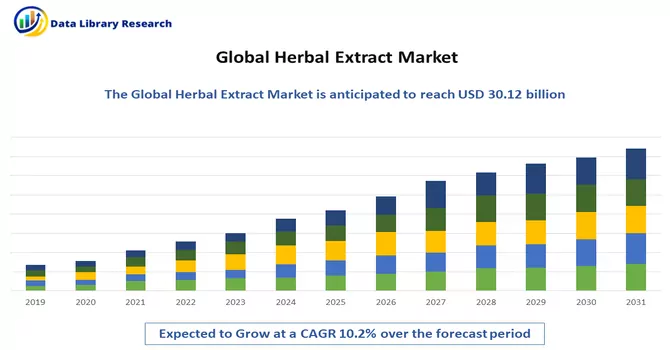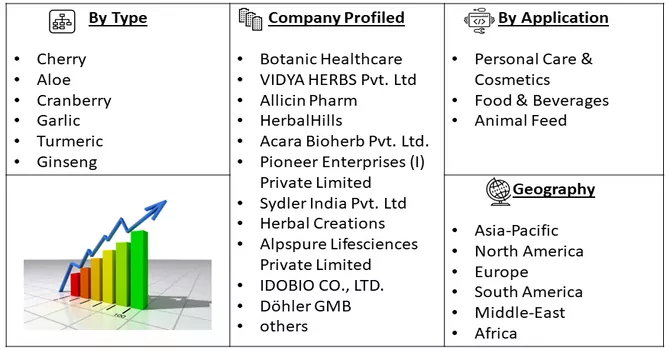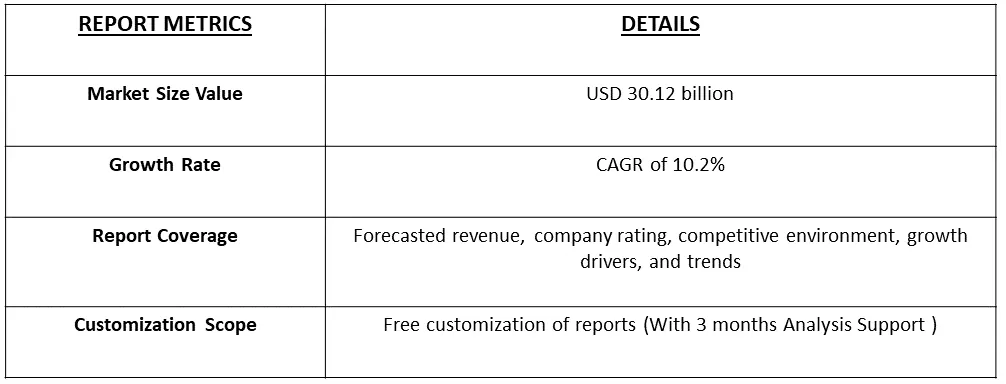The global herbal extract market size was valued at USD 30.12 billion in 2023 and is projected to expand at a compound annual growth rate (CAGR) of 10.2% from 2024 to 2031.

Get Complete Analysis Of The Report - Download Free Sample PDF
Herbal extract refers to a concentrated solution obtained through the extraction of bioactive compounds from plant materials, such as roots, leaves, seeds, or flowers, using solvents or other extraction methods. This process aims to capture and preserve the beneficial properties of the plant, including phytochemicals, antioxidants, and essential oils. Herbal extracts are widely utilized in various industries, including pharmaceuticals, cosmetics, and dietary supplements, for their potential therapeutic and health-promoting effects. The extraction methods may vary, including techniques such as maceration, infusion, or steam distillation, depending on the desired constituents and the plant material being processed. Herbal extracts are valued for their ability to provide concentrated and standardized forms of the active components found in medicinal and aromatic plants, offering a convenient and potent way to incorporate the beneficial properties of herbs into various products and applications.
The market is poised for advancement, driven by a heightened consumer demand for healthier and more natural food and beverage options. The increasing preference for preservative-free, gluten-free, and non-artificial flavored and colored products is a significant catalyst for the growth of herbal extracts. Consumers are increasingly seeking clean-label alternatives, and the use of herbal extracts aligns with these evolving dietary preferences. Additionally, a growing awareness of the therapeutic properties associated with herbs has contributed to a broader acceptance of herbal ingredients in various applications. This shift extends beyond the culinary realm, as there is a noticeable trend toward incorporating herbal extracts into skincare products. Consumers are becoming more conscious of the benefits of herbal components in promoting skin health and addressing specific skincare needs. This dual demand for natural, clean-label foods and herbal-infused skincare solutions is expected to synergistically drive the market for herbal extracts, creating opportunities for innovation and growth in both the food and beverage as well as the personal care industries over the forecast period.
Market Segmentation: The Herbal Extract Market is Segmented By Type (Cherry, Aloe, Cranberry, Garlic, Turmeric, Ginseng), Application (Personal Care & Cosmetics, Food & Beverages, Animal Feed), and Geography (North America, Europe, Asia-Pacific, South America, and Africa). The market size and forecast are provided in terms of value (USD million) for the above segments.

For Detailed Market Segmentation - Download Free Sample PDF
The Herbal Extract Market is witnessing dynamic trends shaped by evolving consumer preferences and a growing emphasis on holistic well-being. A surge in demand for natural and plant-based products has fueled the popularity of herbal extracts, driven by consumers seeking clean-label, preservative-free, and health-conscious options. The market is characterized by a notable uptick in the adoption of herbal extracts in various applications, including food, beverages, and skincare, aligning with the rising awareness of the therapeutic properties associated with botanical ingredients. Furthermore, a shift towards sustainable and eco-friendly practices is influencing sourcing and production methods within the herbal extract industry, with a focus on organic and ethically harvested botanicals. As consumers increasingly prioritize preventive health measures and wellness-centric lifestyles, the Herbal Extract Market is poised for continued growth, driven by innovation, diversification of product offerings, and a holistic approach to consumer well-being.
Market Drivers:
The increasing consumer awareness and demand for natural and plant-based products
The increasing consumer awareness and demand for natural and plant-based products represent a transformative shift in purchasing behaviors and lifestyle choices. In response to a growing consciousness about health, environmental sustainability, and ethical considerations, consumers are actively seeking products that align with these values. This trend is particularly pronounced in the food and beverage, cosmetics, and personal care industries, where consumers prioritize clean-label options and sustainable practices. The demand for natural and plant-based products stems from a desire for transparency in ingredient sourcing, avoidance of synthetic additives, and a preference for environmentally friendly production methods. As consumers become more informed about the impact of their choices on personal well-being and the planet, businesses are adapting by incorporating natural and plant-based ingredients into their formulations. This trend not only reflects a shift in consumer preferences but also underscores a broader cultural movement towards healthier, sustainable, and ethically sourced products across various industries.
The surge in demand for herbal extracts is fueled by a rising interest in preventive healthcare and holistic well-being
The surge in demand for herbal extracts is intrinsically linked to a burgeoning interest in preventive healthcare and holistic well-being among consumers. As individuals increasingly prioritize proactive health measures, there is a growing recognition of the therapeutic and wellness-promoting properties inherent in herbal extracts. The rich array of bioactive compounds found in these botanical extracts is believed to contribute positively to overall health, supporting the body's natural processes and functioning. This shift towards preventive healthcare aligns with a broader cultural movement emphasizing a holistic approach to well-being, encompassing not only physical health but also mental and emotional balance. Consumers are drawn to herbal extracts for their perceived natural and holistic benefits, seeking alternatives to synthetic pharmaceuticals and embracing traditional wisdom in herbal medicine. The demand surge reflects a societal inclination towards self-care and a proactive stance on health, positioning herbal extracts as integral components in the pursuit of holistic well-being.
Marker Restraints:
Market restraints for the Herbal Extracts Market encompass several factors that influence its growth trajectory. One significant challenge is the variability in the quality and standardization of herbal extracts, as achieving consistency in active compound levels can be challenging due to factors like climate, soil conditions, and cultivation practices. Regulatory complexities and the lack of standardized regulations across different regions may pose hurdles, impacting the market's expansion. Additionally, the limited scientific validation for the efficacy of certain herbal extracts and potential interactions with medications may contribute to hesitancy among consumers and regulatory bodies. Supply chain issues related to sourcing specific herbs and ensuring sustainability can also present constraints. Moreover, as the popularity of herbal extracts rises, competition increases, leading to potential issues related to adulteration and authenticity. Overcoming these challenges requires industry-wide collaboration, investment in research, and the development of stringent quality control measures to ensure the reliability and safety of herbal extract products in the market.
The Herbal Extract Market has experienced notable shifts in the wake of the COVID-19 pandemic. The increased focus on health and wellness during the global health crisis has propelled the demand for herbal extracts, with consumers seeking products perceived to offer immune-boosting and overall well-being benefits. The pandemic has underscored the significance of preventive healthcare, leading to a surge in interest in natural and plant-based remedies. While disruptions in the supply chain and uncertainties in raw material sourcing posed initial challenges, the adaptability and resilience of the herbal extract industry have enabled it to navigate through the pandemic's impact. As consumers continue to prioritize holistic health and immunity, the Herbal Extract Market is poised for sustained growth, with the pandemic serving as a catalyst for the adoption of herbal solutions in diverse applications, including dietary supplements, functional foods, and personal care products.
Segmental Analysis:
Aloe Segments is Expected to Witness Significant Growth Over the Forecast Period
Aloe Herbal Extract, derived from the Aloe vera plant, holds a prominent position in the realm of herbal extracts due to its versatile and beneficial properties. Widely recognized for its therapeutic and skincare attributes, Aloe vera has been utilized for centuries for its soothing and moisturizing effects. Aloe Herbal Extract is rich in bioactive compounds, including polysaccharides, vitamins, and antioxidants, contributing to its anti-inflammatory and healing characteristics. In the skincare industry, Aloe Herbal Extract is incorporated into various formulations such as creams, lotions, and gels, offering hydration, alleviating skin irritations, and promoting overall skin health. Moreover, Aloe vera's traditional uses extend to digestive health, and its extract is often found in dietary supplements and functional beverages. With the increasing consumer demand for natural and plant-based products, Aloe Herbal Extract continues to gain popularity for its diverse applications and holistic well-being attributes across the skincare, dietary supplement, and functional food industries.
Personal Care & Cosmetics is Expected to Witness Significant Growth Over the Forecast Period
The intersection of Personal Care & Cosmetics and Herbal Extracts signifies a growing trend towards natural and plant-based ingredients in beauty and skincare formulations. Herbal extracts have become integral components in the personal care and cosmetics industry, driven by consumer preferences for clean and green beauty products. Extracts from herbs like chamomile, lavender, green tea, and aloe vera are infused into skincare products, shampoos, conditioners, and other cosmetic formulations for their natural, soothing, and nourishing properties. These herbal extracts are known for their potential to rejuvenate the skin, provide antioxidant benefits, and address various skincare concerns. As consumers increasingly prioritize wellness and seek products with minimal synthetic additives, the use of herbal extracts in personal care and cosmetics has gained traction, reflecting a broader shift towards holistic beauty solutions. This trend not only aligns with evolving consumer preferences but also underscores the industry's commitment to sustainability and the incorporation of nature-inspired ingredients in enhancing overall skincare and beauty routines.
North America Region is Expected to Witness Significant Growth Over the Forecast Period
In North America, the Herbal Extract market is witnessing significant growth driven by a burgeoning consumer inclination towards natural and plant-based products. The region's dynamic wellness industry and the increasing awareness of holistic well-being have propelled the demand for herbal extracts across diverse applications. Consumers in North America are embracing the therapeutic and health-promoting properties of herbal extracts, leading to their incorporation in dietary supplements, functional foods, and skincare formulations. The trend aligns with a broader cultural shift towards clean-label alternatives and sustainable practices, as individuals seek products that resonate with their values of health consciousness and environmental responsibility. With a robust market ecosystem, including innovative product offerings and a focus on quality standards, North America stands as a key player in the global herbal extract landscape, reflecting the region's evolving preferences and commitment to natural solutions.

Get Complete Analysis Of The Report - Download Free Sample PDF
The analyzed market exhibits a high degree of fragmentation, primarily attributable to the presence of numerous players operating on both a global and regional scale. The competitive landscape is characterized by a diverse array of companies, each contributing to the overall market dynamics. This fragmentation arises from the existence of specialized solution providers, established industry players, and emerging entrants, all vying for market share. The diversity in market participants is underscored by the adoption of various strategies aimed at expanding the company's presence. On a global scale, companies within the studied market are strategically positioning themselves through aggressive expansion initiatives. This often involves entering new geographical regions, targeting untapped markets, and establishing a robust global footprint. The pursuit of global expansion is driven by the recognition of diverse market opportunities and the desire to capitalize on emerging trends and demands across different regions. Simultaneously, at the regional level, companies are tailoring their approaches to align with local market dynamics. Regional players are leveraging their understanding of specific market nuances, regulatory environments, and consumer preferences to gain a competitive edge. This regional focus allows companies to cater to the unique needs of local clientele, fostering stronger market penetration. To navigate the complexities of the fragmented market, companies are implementing a range of strategies. These strategies include investments in research and development to stay at the forefront of technological advancements, mergers and acquisitions to consolidate market share, strategic partnerships for synergies, and innovation to differentiate products and services. The adoption of such multifaceted strategies reflects the competitive nature of the market, with participants continually seeking avenues for growth and sustainability. In essence, the high fragmentation in the studied market not only signifies the diversity of players but also underscores the dynamism and competitiveness that drive ongoing strategic maneuvers. As companies explore various avenues for expansion, the market continues to evolve, presenting both challenges and opportunities for industry stakeholders.
Key Herbal Extract Companies:
Recent Development:
1) In May 2023, GNT unveiled a groundbreaking addition to its EXBERRY brand with the introduction of Shade Vivid Orange - OS. This marks the first-ever 100% oil-soluble, plant-derived colour crafted by the company, derived from non-GMO paprika. This innovative product brings forth a versatile and vibrant orange hue, uniquely positioned to serve as a substitute for paprika oleoresin and synthetic colours across a spectrum of applications. Notably, Shade Vivid Orange - OS proves exceptionally valuable in fat-based sweet and savoury products, showcasing its adaptability and potential to enhance the visual appeal of various food items. The utilization of non-GMO paprika underscores GNT's commitment to natural sourcing and sustainable practices, contributing to the company's portfolio of plant-based colour solutions that cater to the evolving demands of the food and beverage industry.
2) In 2021, a state-of-the-art facility was inaugurated with a focus on the production of standardized herbal extracts, phytochemicals, organic herbal extracts, and nutraceutical ingredients. This facility is geared towards serving leading dietary and food supplement manufacturers worldwide. Manipal Natural highlights the anticipated growth in the global medicinal plant extracts market, attributing it to a rising demand for herbal supplements. The company foresees substantial economic impact as the 5-acre facility is expected to generate employment for 200 individuals, as stated by Chairman Shri Sudhakar Pai. Additionally, with future expansion plans in mind, the company has acquired an additional 17 acres of land, signalling a commitment to continued growth and the creation of more employment opportunities in the near future.
Q1. What was the Herbal Extract Market size in 2023?
As per Data Library Research the global herbal extract market size was valued at USD 30.12 billion in 2023.
Q2. At what CAGR is the Herbal Extract market projected to grow within the forecast period?
Herbal Extract Market is projected to expand at a compound annual growth rate (CAGR) of 10.2% over the forecast period.
Q3. What are the factors on which the Herbal Extract market research is based on?
By Type, By Application and Geography are the factors on which the Herbal Extract market research is based.
Q4. Which Region is expected to hold the highest Market share?
North America region is expected to hold the highest Market share.
Data Library Research are conducted by industry experts who offer insight on industry structure, market segmentations technology assessment and competitive landscape (CL), and penetration, as well as on emerging trends. Their analysis is based on primary interviews (~ 80%) and secondary research (~ 20%) as well as years of professional expertise in their respective industries. Adding to this, by analysing historical trends and current market positions, our analysts predict where the market will be headed for the next five years. Furthermore, the varying trends of segment & categories geographically presented are also studied and the estimated based on the primary & secondary research.
In this particular report from the supply side Data Library Research has conducted primary surveys (interviews) with the key level executives (VP, CEO’s, Marketing Director, Business Development Manager and SOFT) of the companies that active & prominent as well as the midsized organization
FIGURE 1: DLR RESEARH PROCESS

Extensive primary research was conducted to gain a deeper insight of the market and industry performance. The analysis is based on both primary and secondary research as well as years of professional expertise in the respective industries.
In addition to analysing current and historical trends, our analysts predict where the market is headed over the next five years.
It varies by segment for these categories geographically presented in the list of market tables. Speaking about this particular report we have conducted primary surveys (interviews) with the key level executives (VP, CEO’s, Marketing Director, Business Development Manager and many more) of the major players active in the market.
Secondary ResearchSecondary research was mainly used to collect and identify information useful for the extensive, technical, market-oriented, and Friend’s study of the Global Extra Neutral Alcohol. It was also used to obtain key information about major players, market classification and segmentation according to the industry trends, geographical markets, and developments related to the market and technology perspectives. For this study, analysts have gathered information from various credible sources, such as annual reports, sec filings, journals, white papers, SOFT presentations, and company web sites.
Market Size EstimationBoth, top-down and bottom-up approaches were used to estimate and validate the size of the Global market and to estimate the size of various other dependent submarkets in the overall Extra Neutral Alcohol. The key players in the market were identified through secondary research and their market contributions in the respective geographies were determined through primary and secondary research.
Forecast Model
